April 1, 2021
Scientific breakthrough of the decade halts lab construction
Groundbreaking discovery pauses construction project of new library and chemistry building at IST Austria
This article is a work of science fiction and was published on April Fools’ Day.
Always keep a critical mind to distinguish between fake news and scientific fact.
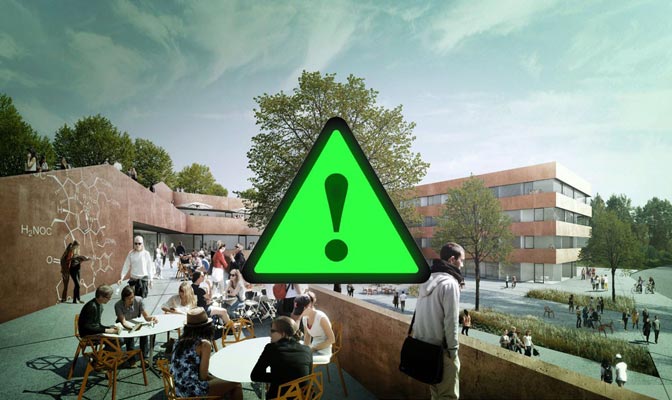
© IST Austria
In addition to Corona, a new incident delayed construction work on Laboratory Building 5 of the Institute of Science and Technology Austria (IST Austria). The cause has Nobel Prize potential: A hitherto unknown, shimmering green fungal infestation astonishes scientists on campus and around the world.
Last Monday, construction work on the new chemistry and library building at the Institute of Science and Technology Austria (IST Austria) had to be abruptly interrupted. The construction workers were amazed when some walls of Laboratory 5 emitted a dull glow. The site was immediately evacuated, and the emergency services were alerted. “Safety – like excellence, interdisciplinarity, diversity and curiosity – is our very first priority,” assured President Tom A. Henzinger, “but in this case it was a Nature Cover Story!” A team consisting of representatives from all the Institute’s disciplines immediately set out to clarify the origin of the ghostly green glow.
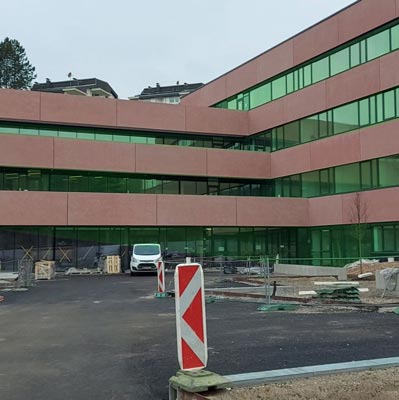
© Angry local residents/IST Austria
“Like being in another world”
The internal Scientific Service Units provided the scientists with full-body protective suits from the Clean Room, Professor Fink contributed a quantum radar, and Professor Browning equipped the team with a brand-new 15-digit solution to a Diophantine equation.
“When we entered the building, it was suddenly like being in another world,” Vice Executive President and cell biologist Michael Sixt reports of the expedition. “For safety reasons, the building’s power lines had been cut, so the ghostly glow was the only source of light.” The research team determined how far the phenomenon had spread. Because of the finite size of the spread, physicist Maksym Serbyn was able to distinguish between chaos and localization. “Nanocrystals in the cement would have caused a homogeneous distribution of the glow, so when it comes to the question of origin we were able to rule them out,” explains Maria Ibáñez, professor of functional nanomaterials. “The luminescence pattern suggests an organic source.”
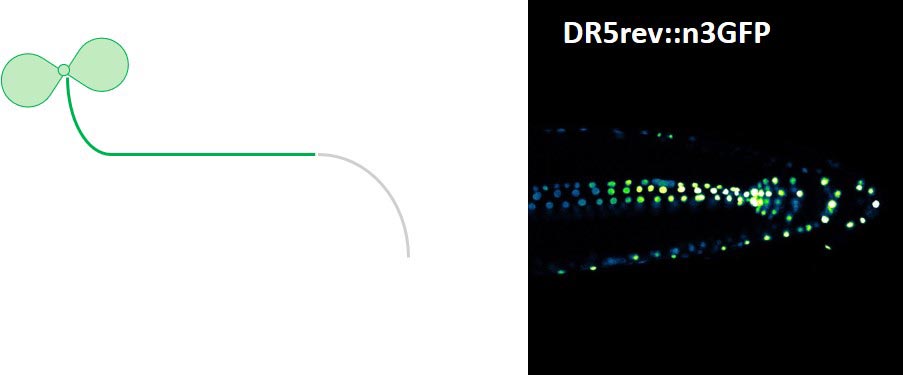
The scientists Kondrashov, Benková and Friml came up with a groundbreaking hypothesis. Since the discovery of the key gene in the fungus Neonothopanus nambi, which Professor Kondrashov had already used to make yeast glow, the now neglected fungi had started to search for nutrients on their own. “We know the mechanism of Arabidopsis seedlings,” explains developmental biologist Benková. “When a plant vegetates in suboptimal soil, it tries to maintain its growth as long as possible in order to find a more suitable source of nutrients. The fact that this also happens in spore-forming organisms, and especially over such distances, this in itself is a major scientific breakthrough!”
By chance, the hungry fungus must have discovered a salicylic acid deposit nearby. The substance is found in painkillers such as aspirin and ibuprofen. The drugs are stored in every desk at the Institute for the time-critical preparation of grant proposals in competitive, cutting-edge application calls. Jiří Friml, cell biologist says: “As we recently published in the journal Cell Reports, painkillers interfere with the flow of the plant hormone auxin, which is responsible for orientation. The fungus found it in the desk, then virtually lost its way and settled in Laboratory 5.”
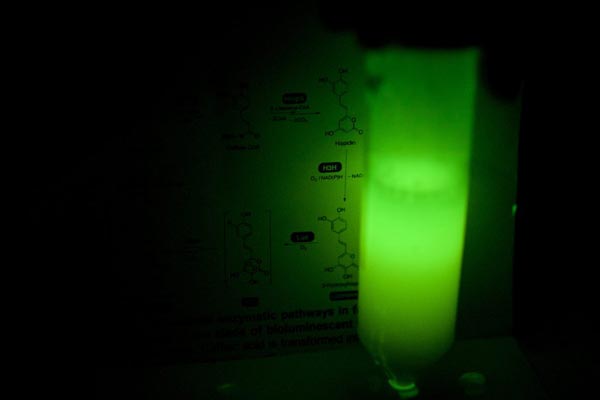
When the expedition squad returned and announced the findings, frenetic cheers erupted and, according to ear witnesses, Professor Kondrashov and President Henzinger performed an impromptu sea shanty in perfect harmony together. Uncertain are the exact effects of the aspirin on Neonothopanus nambi and the reason for its settlement at the construction site. Its relation to the nearly 15 Tesla strong magnets of physicist Kimberly Modic, which have just been delivered to Lab West, is mere speculation at this stage.
Faster than mathematics allows
In high spirits, the faculty members consulted over coffee – the fuel of lived interdisciplinarity – at safety distance about how to proceed. “Even during the first espresso, colleague Sweeney and I submitted an ERC grant proposal for research on cell migration in new laboratory sites,” Michael Sixt proudly announced. The ERC grant for Professor Johann Danzl, who suspects new switchable fluorescent proteins (RSFP) for femtoscopy in the fungus, had already been approved by the end of the melange. More productive was only mathematician Julian Fischer.
He modeled the organism’s boundaries according to the gradient descent of the surface functional and published three new papers in prestigious journals overnight. However, the partial differential equations gave too weak solutions, as the glow far outshone the calculated increase the next morning. “Random processes are often so irregular that existing mathematical methods fall short,” admits Jan Maas, professor of analytical stochastics and stochastic analysis. “In this particular case, however, we are by no means assuming randomness.” Off the record, many faculty members suspect a fly-by-night operation by Professor Kolmogorov, who is known for his discrete optimizations – most recently, he secretly shortened the travel time from Vienna to the Institute to a four days’ journey.
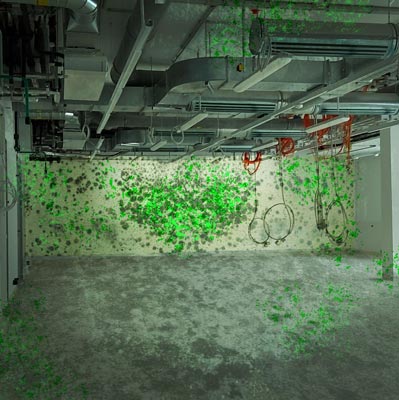
The strong luminous activity was taken as an opportunity to put a revolutionary proposal by Prof. Stefan Freunberger into practice. He has been working for years with electrochemical materials for storing and generating energy. In the campaign “IST Austria vaccinates”, all other buildings are now to be “vaccinated” with the luminous mushroom. But the plans are even more ambitious.
Pioneering green tech initiative at IST Austria
In a further step, the photoelectric energy of the buildings is to be harnessed economically and the IST Austria expanded into the first bioluminar power plant. „These buildings will become bioenergy plants in the truest sense of the word plant”, celebrates President Thomas A. Henzinger. Behind Buildings 5 and 6, which are currently under construction, a further eleven buildings will be built until 2030, while a complete expansion of the campus up to and including Redlinger Hütte is planned by 2040. The resources for the expansion were quickly mobilized. “The state of Lower Austria has stood for green power production and technological innovation for years and will of course co-finance this enlargement,” says Governor Johanna Mikl-Leitner energetically. For his part, Minister of Education Heinz Faßmann confirms the subsidies from the federal government in the form of multi-mobile spectral filters, de facto sunglasses in the green light range, for the residents in Maria Gugging.
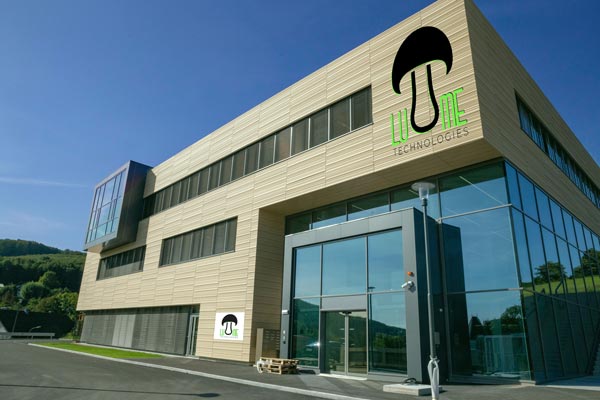
IST Austria plans to raise the bulk of the investment through an in-house startup. “Lume Technologies makes bio-luminescent technologies in various forms ready for the market,” Managing Director Georg Schneider announces. Expectations are high. The fungus is to be used as an intermediate genus to specifically make both plants and animals glow. The hope is for lume trees – trees that replace street lamps – and so-called illuminANTS. The bio-florescent ants could soon replace all ants in terrestrial bread boxes and spark a revolution in the kitchen lighting industry. “We expect a lot of resistance from the ant trap lobby,” ant researcher Sylvia Cremer admits, but is undeterred. “But let them come. Our science colony here in Gugging is collectively protected by our individual behavior and strong social interactions. Besides, cool moldy glow ants always win the battle!”



